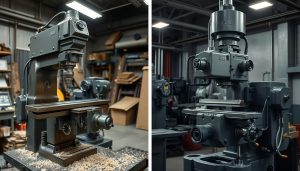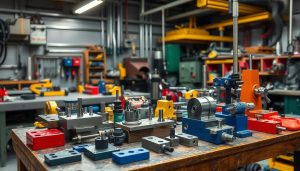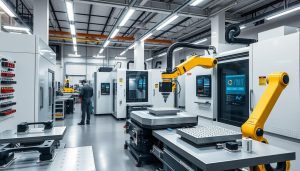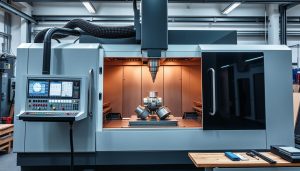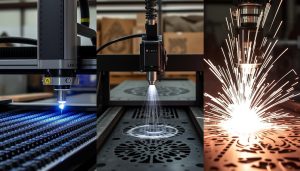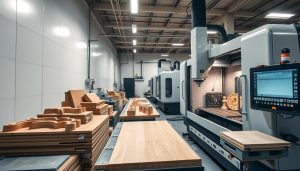In the world of manufacturing, two widely adopted processes stand out – machining and sheet metal fabrication. Both methods play a crucial role in shaping the products and components that power various industries, from aerospace to automotive. As a business owner or project manager, choosing the right manufacturing approach can make all the difference in the success of your venture.
This article delves into the intricacies of machining and sheet metal fabrication, exploring their distinct characteristics, applications, and the factors to consider when selecting the best method for your specific project needs. By understanding the strengths and limitations of each process, you can make an informed decision that aligns with your manufacturing goals, cost constraints, and production timelines.
What is Machining?
Machining is a fundamental process in the world of precision manufacturing. It involves the controlled removal of material from a workpiece to create a desired shape, size, and finish. This material removal technique is essential for producing complex parts with tight tolerances, making it a crucial component in industries ranging from aerospace to automotive.
Overview of the Machining Process
At the heart of machining lies the use of specialized tools, such as lathes, mills, and drills, to cut, shape, and polish the material. These tools are meticulously controlled, often with the aid of CNC (Computer Numerical Control) technology, to ensure the highest levels of precision and accuracy. The machining process typically involves clamping the workpiece in place, applying cutting tools, and precisely controlling the speed, feed, and depth of the cuts to achieve the desired outcome.
Types of Machining: CNC, Turning, Milling
- CNC Machining utilizes computer programs to automate the machining process, enabling the production of intricate parts with unparalleled consistency and efficiency.
- Turning is a machining operation that involves rotating the workpiece while a cutting tool removes material to create cylindrical or conical shapes.
- Milling is another common machining technique that uses a rotating cutter to remove material from the workpiece, allowing for the creation of complex geometries and features.
Materials Used in Machining
Machining can be applied to a wide range of materials, including metals, plastics, and composites. Some of the most commonly machined materials include aluminum, stainless steel, titanium, and engineering plastics. The choice of material depends on the specific requirements of the project, such as strength, weight, and corrosion resistance, as well as the desired aesthetic qualities.
Through the precise material removal techniques of machining, manufacturers can achieve the high levels of precision manufacturing required for a vast array of applications, making it a pivotal process in modern industry.
What is Sheet Metal Fabrication?
Sheet metal fabrication is a versatile manufacturing process that involves shaping flat metal sheets into various products. This technique allows for the creation of a wide range of metal components, from simple parts to complex structures, all while leveraging the inherent strength and durability of sheet metal materials.
Overview of the Sheet Metal Fabrication Process
The sheet metal fabrication process typically begins with cutting the metal sheet to the desired shape using techniques like laser cutting, stamping, or punching. Once the initial shape is achieved, the metal is then bent, folded, or welded to form the desired three-dimensional structure. This process can be repeated multiple times to create intricate designs and assemblies.
Types of Sheet Metal Fabrication: Cutting, Bending, Welding
- Cutting: Sheet metal can be precisely cut using advanced techniques like laser cutting, plasma cutting, or water jet cutting to achieve complex shapes and designs.
- Bending: Bending is a fundamental sheet metal fabrication process that allows for the creation of angles, curves, and other geometric forms. This is often done using specialized machinery like press brakes or rotary benders.
- Welding: Welding is a critical step in sheet metal fabrication, as it allows for the seamless joining of multiple metal components to create robust and sturdy assemblies. Common welding techniques used in this process include MIG, TIG, and spot welding.
Materials Used in Sheet Metal Fabrication
Sheet metal fabrication can utilize a variety of metal materials, including steel, aluminum, stainless steel, copper, and brass. The choice of material depends on the specific requirements of the project, such as strength, durability, corrosion resistance, and aesthetic considerations.
| Material | Characteristics | Common Applications |
|---|---|---|
| Steel | Durable, strong, and cost-effective | Automotive parts, construction materials, industrial equipment |
| Aluminum | Lightweight, corrosion-resistant, and easy to fabricate | Aerospace components, consumer electronics, transportation |
| Stainless Steel | Corrosion-resistant, durable, and easy to clean | Food processing equipment, medical devices, architectural elements |
Sheet metal fabrication offers a highly efficient and versatile approach to creating a wide range of metal shaping, fabrication techniques, and sheet metal products. Its adaptability and precision make it a valuable tool for designers, engineers, and manufacturers across various industries.

Key Differences Between Machining and Sheet Metal Fabrication
When it comes to manufacturing, two of the most common methods are machining and sheet metal fabrication. While both techniques aim to create precise components, they differ in their fundamental processes and capabilities. Understanding these key differences is crucial when choosing the right approach for your project.
Process: Material Removal vs. Material Shaping
Machining is a subtractive process, where material is removed from a solid block or workpiece to create the desired shape. This typically involves tools like lathes, mills, and drill presses, which precisely carve out the part. In contrast, sheet metal fabrication is an additive process, where flat metal sheets are cut, bent, and joined to form the final product. This method is well-suited for creating complex shapes and structures.
Precision and Tolerances: CNC Machining vs. Fabrication
CNC (Computer Numerical Control) machining offers exceptional precision, often achieving tolerances within a few thousandths of an inch. This makes it an ideal choice for parts that require tight specifications, such as those found in aerospace and medical industries. Sheet metal fabrication, while highly versatile, generally has a wider tolerance range, making it more suitable for projects that don’t require the same level of precision.
Cost and Efficiency: Which Method is More Cost-Effective?
The cost-effectiveness of machining versus sheet metal fabrication largely depends on the project’s complexity and production volume. Machining is generally more cost-effective for low-volume, highly customized parts, as it requires less tooling and setup time. However, for high-volume, standardized parts, sheet metal fabrication can be more efficient and cost-effective due to its streamlined manufacturing process.
| Criteria | Machining | Sheet Metal Fabrication |
|---|---|---|
| Process | Subtractive: Material removal | Additive: Material shaping |
| Precision | Excellent (CNC: Tight tolerances) | Good (Wider tolerance range) |
| Cost-Effectiveness | Low-volume, highly customized parts | High-volume, standardized parts |
By understanding the key differences between machining and sheet metal fabrication, manufacturers can make informed decisions on the most suitable approach for their manufacturing comparison, production efficiency, and cost analysis requirements.

Applications of Machining and Sheet Metal Fabrication
When it comes to industrial applications, both machining and sheet metal fabrication play crucial roles in transforming raw materials into custom parts and products. The choice between these two manufacturing methods often depends on the specific requirements of the project, the complexity of the design, and the desired production volume.
When to Choose Machining
Machining is particularly well-suited for creating highly precise and intricate custom parts. Industries such as aerospace, medical device manufacturing, and high-end equipment production often rely on machining to achieve the level of accuracy and quality needed for their industrial applications. Machining is also the preferred method for producing small to medium-sized batches of parts, where the flexibility and control offered by CNC machines can be leveraged effectively.
When to Choose Sheet Metal Fabrication
On the other hand, sheet metal fabrication excels in large-scale production scenarios, such as automotive body panels, HVAC ductwork, and the manufacture of custom parts for a variety of industries. The efficient and cost-effective nature of sheet metal fabrication processes, including cutting, bending, and welding, make it the ideal choice for large-scale production runs where standardized parts are required.
Ultimately, the decision to choose machining or sheet metal fabrication for a project depends on a careful evaluation of the specific requirements, production volume, and overall cost-effectiveness of each method. By understanding the strengths and limitations of these two manufacturing approaches, project managers can make informed decisions that align with the unique needs of their industrial applications.
Choosing the Right Method for Your Project
When it comes to manufacturing your project, selecting the appropriate method can make all the difference. Whether you choose machining or sheet metal fabrication, several key factors should guide your decision-making process. Part complexity, production volume, and material requirements are crucial considerations that will help you optimize your manufacturing strategy and achieve the best possible outcomes.
Factors to Consider: Complexity, Volume, and Material Type
For complex parts with intricate features and tight tolerances, CNC machining often emerges as the superior choice. This precision-driven approach excels at creating highly detailed components with exceptional accuracy. On the other hand, if your project requires the fabrication of simple, standardized parts in high volumes, sheet metal fabrication may prove more cost-effective and efficient.
The material composition of your parts is another essential factor. Machining is versatile, accommodating a wide range of materials, from metals to plastics and composites. Sheet metal fabrication, however, is particularly well-suited for working with sheet metal alloys, such as aluminum, steel, and stainless steel. Understanding the unique properties and performance requirements of your materials can help you determine the optimal manufacturing method.
By carefully considering the complexity of your project, the expected production volume, and the specific material needs, you can make an informed decision that aligns your manufacturing approach with your project’s unique requirements. This thoughtful planning will not only ensure the successful execution of your project but also optimize your production costs and efficiency.
